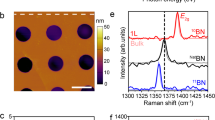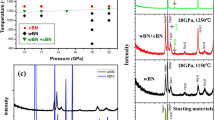Abstract
If a bulk material can withstand a high load without any irreversible damage (such as plastic deformation), it is usually brittle and can fail catastrophically1,2. This trade-off between strength and fracture toughness also extends into two-dimensional materials space3,4,5. For example, graphene has ultrahigh intrinsic strength (about 130 gigapascals) and elastic modulus (approximately 1.0 terapascal) but is brittle, with low fracture toughness (about 4 megapascals per square-root metre)3,6. Hexagonal boron nitride (h-BN) is a dielectric two-dimensional material7 with high strength (about 100 gigapascals) and elastic modulus (approximately 0.8 terapascals), which are similar to those of graphene8. Its fracture behaviour has long been assumed to be similarly brittle, subject to Griffith’s law9,10,11,12,13,14. Contrary to expectation, here we report high fracture toughness of single-crystal monolayer h-BN, with an effective energy release rate up to one order of magnitude higher than both its Griffith energy release rate and that reported for graphene. We observe stable crack propagation in monolayer h-BN, and obtain the corresponding crack resistance curve. Crack deflection and branching occur repeatedly owing to asymmetric edge elastic properties at the crack tip and edge swapping during crack propagation, which intrinsically toughens the material and enables stable crack propagation. Our in situ experimental observations, supported by theoretical analysis, suggest added practical benefits and potential new technological opportunities for monolayer h-BN, such as adding mechanical protection to two-dimensional devices.
This is a preview of subscription content, access via your institution
Access options
Access Nature and 54 other Nature Portfolio journals
Get Nature+, our best-value online-access subscription
$29.99 / 30 days
cancel any time
Subscribe to this journal
Receive 51 print issues and online access
$199.00 per year
only $3.90 per issue
Buy this article
- Purchase on Springer Link
- Instant access to full article PDF
Prices may be subject to local taxes which are calculated during checkout




Similar content being viewed by others
Data availability
The data that support the findings of this study are available from the corresponding authors upon reasonable request.
Code availability
The LabView codes used in this work are available from the corresponding authors upon reasonable request.
References
Ritchie, R. O. The conflicts between strength and toughness. Nat. Mater. 10, 817–822 (2011).
Ritchie, R. O. Mechanisms of fatigue crack propagation in metals, ceramics and composites: role of crack tip shielding. Mater. Sci. Eng. A 103, 15–28 (1988).
Zhang, P. et al. Fracture toughness of graphene. Nat. Commun. 5, 3782 (2014).
Becton, M. & Wang, X. Grain-size dependence of mechanical properties in polycrystalline boron-nitride: a computational study. Phys. Chem. Chem. Phys. 17, 21894–21901 (2015).
Cammarata, R. C. Surface and interface stress effects in thin films. Prog. Surf. Sci. 46, 1–38 (1994).
Wang, S. S. et al. Atomically sharp crack tips in monolayer MoS2 and their enhanced toughness by vacancy defects. ACS Nano 10, 9831–9839 (2016).
Lee, C., Wei, X. D., Kysar, J. W. & Hone, J. Measurement of the elastic properties and intrinsic strength of monolayer graphene. Science 321, 385–388 (2008).
Li, L. H. et al. Dielectric screening in atomically thin boron nitride nanosheets. Nano Lett. 15, 218–223 (2015).
Akinwande, D. et al. A review on mechanics and mechanical properties of 2D materials—graphene and beyond. Extreme Mech. Lett. 13, 42–77 (2017).
Falin, A. et al. Mechanical properties of atomically thin boron nitride and the role of interlayer interactions. Nat. Commun. 8, 15815 (2017).
Kumar, R. & Parashar, A. Fracture toughness enhancement of h-BN monolayers via hydrogen passivation of a crack edge. Nanotechnology 28, 165702 (2017).
Tabarraei, A. & Wang, X. A molecular dynamics study of nanofracture in monolayer boron nitride. Mater. Sci. Eng. A 641, 225–230 (2015).
Rakib, T., Mojumder, S., Das, S., Saha, S. & Motalab, M. Graphene and its elemental analogue: a molecular dynamics view of fracture phenomenon. Phys. Rev. B 515, 67–74 (2017).
Ahmed, T., Procak, A., Hao, T. & Hossain, Z. M. Strong anisotropy in strength and toughness in defective hexagonal boron nitride. Phys. Rev. B 99, 134105 (2019).
Yang, Y. C. et al. Brittle fracture of 2D MoSe2. Adv. Mater. 29, 1604201 (2017).
McMeeking, R. M. & Evans, A. G. Mechanics of transformation-toughening in brittle materials. J. Am. Ceram. Soc. 65, 242–246 (1982).
Budiansky, B., Hutchinson, J. W. & Lambropoulos, J. C. Continuum theory of dilatant transformation toughening in ceramics. Int. J. Solids Struct. 19, 337–355 (1983).
Levitas, V. I. & Samani, K. Size and mechanics effects in surface-induced melting of nanoparticles. Nat. Commun. 2, 284 (2011).
Diao, J. K., Gall, K. & Dunn, M. L. Surface-stress-induced phase transformation in metal nanowires. Nat. Mater. 2, 656–660 (2003).
Shenoy, V. B., Reddy, C. D., Ramasubramaniam, A. & Zhang, Y. W. Edge-stress-induced warping of graphene sheets and nanoribbons. Phys. Rev. Lett. 101, 245501 (2008).
Lu, G. Y. et al. Synthesis of high-quality graphene and hexagonal boron nitride monolayer in-plane heterostructure on Cu-Ni alloy. Adv. Sci. 4, 1700076 (2017).
Lu, G. Y. et al. Synthesis of large single-crystal hexagonal boron nitride grains on Cu-Ni alloy. Nat. Commun. 6, 6160 (2015).
Song, L. et al. Large scale growth and characterization of atomic hexagonal boron nitride layers. Nano Lett. 10, 3209–3215 (2010).
Deng, J. K., Fampiou, I., Liu, J. Z., Ramasubramaniam, A. & Medhekar, N. V. Edge stresses of non-stoichiometric edges in two-dimensional crystals. Appl. Phys. Lett. 100, 251906 (2012).
Ly, T. H., Zhao, J., Cichocka, M. O., Li, L. J. & Lee, Y. H. Dynamical observations on the crack tip zone and stress corrosion of two-dimensional MoS2. Nat. Commun. 8, 14116 (2017).
Yankowitz, M. et al. Dynamic band-structure tuning of graphene moiré superlattices with pressure. Nature 557, 404–408 (2018).
Levendorf, M. P. et al. Graphene and boron nitride lateral heterostructures for atomically thin circuitry. Nature 488, 627–632 (2012).
Liu, Z. et al. In-plane heterostructures of graphene and hexagonal boron nitride with controlled domain sizes. Nat. Nanotechnol. 8, 119–124 (2013).
Liu, Y. et al. Van der Waals heterostructures and devices. Nat. Rev. Mater. 1, 16042 (2016).
Hacopian, E. F. et al. Toughening graphene by integrating carbon nanotubes. ACS Nano 12, 7901–7910 (2018).
Buehler, M. J. & Gao, H. J. Dynamical fracture instabilities due to local hyperelasticity at crack tips. Nature 439, 307–310 (2006).
Buehler, M. J., Abraham, F. F. & Gao, H. J. Hyperelasticity governs dynamic fracture at a critical length scale. Nature 426, 141–146 (2003).
Zhu, T. & Li, J. Ultra-strength materials. Prog. Mater. Sci. 55, 710–757 (2010).
Griffith, A. A. VI. The phenomena of rupture and flow in solids. Phil. Trans. R. Soc. Lond. A 221, 163–198 (1921).
Acknowledgements
J.L., Y.Y., H.G. and B.N. gratefully acknowledge financial support by the US Department of Energy, Office of Basic Energy Sciences, under grant number DE-SC0018193. The simulations were performed on resources provided by the Extreme Science and Engineering Discovery Environment through grant MSS090046 and the Center for Computation and Visualization, Brown University.
Author information
Authors and Affiliations
Contributions
Y.Y. and J.L. designed the experiments and analysed the data. Z.S., B.N., X.L. and H.G. performed simulations and analysed the results. G.L. and X. X. grew h-BN. Q.Z. and L.G. performed TEM analysis. Y.Y., B.Z. and C.W. transferred h-BN and carried out in situ tensile tests. Y.Y. and Z.S., supervised by J.L. and H.G., drafted the manuscript with input, discussion and approval from all co-authors. Y.Y. and Z.S. contributed equally to this work.
Corresponding authors
Ethics declarations
Competing interests
The authors declare no competing interests.
Additional information
Peer review information Nature thanks Matthew Begley and the other, anonymous, reviewer(s) for their contribution to the peer review of this work.
Publisher’s note Springer Nature remains neutral with regard to jurisdictional claims in published maps and institutional affiliations.
Supplementary information
Supplementary Information
This file contains supplementary text, supplementary equations s1 – s9, supplementary figure s1 – s14, supplementary tables s1 – s6 and supplementary references.
Supplementary Video 1
In situ tensile test of monolayer h-BN without pre-crack.
Supplementary Video 2
In situ tensile test of monolayer h-BN with pre-crack.
Supplementary Video 3
Quasi-static tensile test of monolayer h-BN channel with pre-crack (~80 nm) coloured by σyy contour.
Rights and permissions
About this article
Cite this article
Yang, Y., Song, Z., Lu, G. et al. Intrinsic toughening and stable crack propagation in hexagonal boron nitride. Nature 594, 57–61 (2021). https://doi.org/10.1038/s41586-021-03488-1
Received:
Accepted:
Published:
Issue Date:
DOI: https://doi.org/10.1038/s41586-021-03488-1
This article is cited by
-
Creating chirality in the nearly two dimensions
Nature Materials (2024)
-
Twisted-layer boron nitride ceramic with high deformability and strength
Nature (2024)
-
Mechanics of 2D material bubbles
Nano Research (2023)
-
Experimentally measuring weak fracture toughness anisotropy in graphene
Communications Materials (2022)
-
Mechanical and thermal characterizations of nanoporous two-dimensional boron nitride membranes
Scientific Reports (2022)
Comments
By submitting a comment you agree to abide by our Terms and Community Guidelines. If you find something abusive or that does not comply with our terms or guidelines please flag it as inappropriate.



